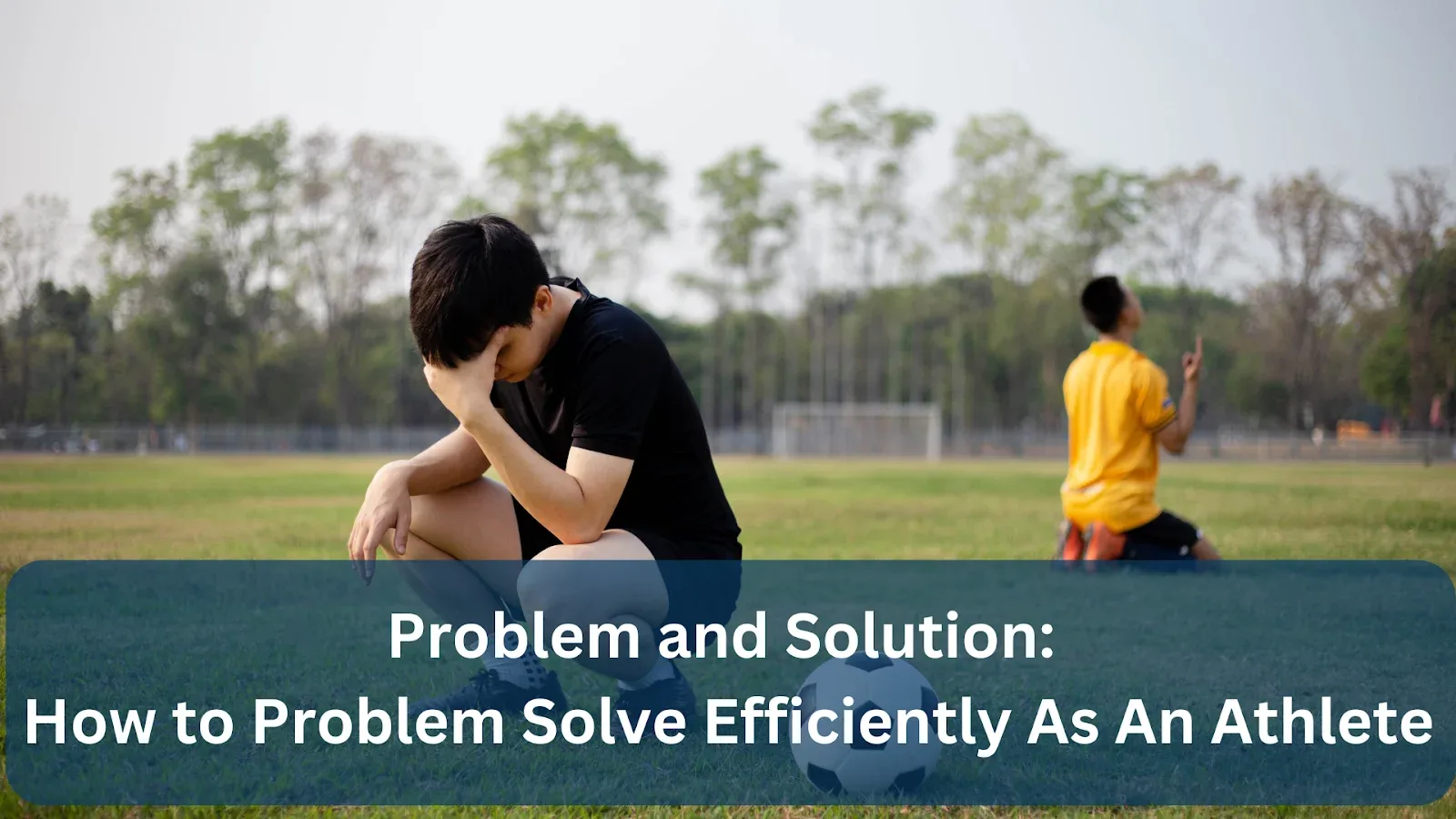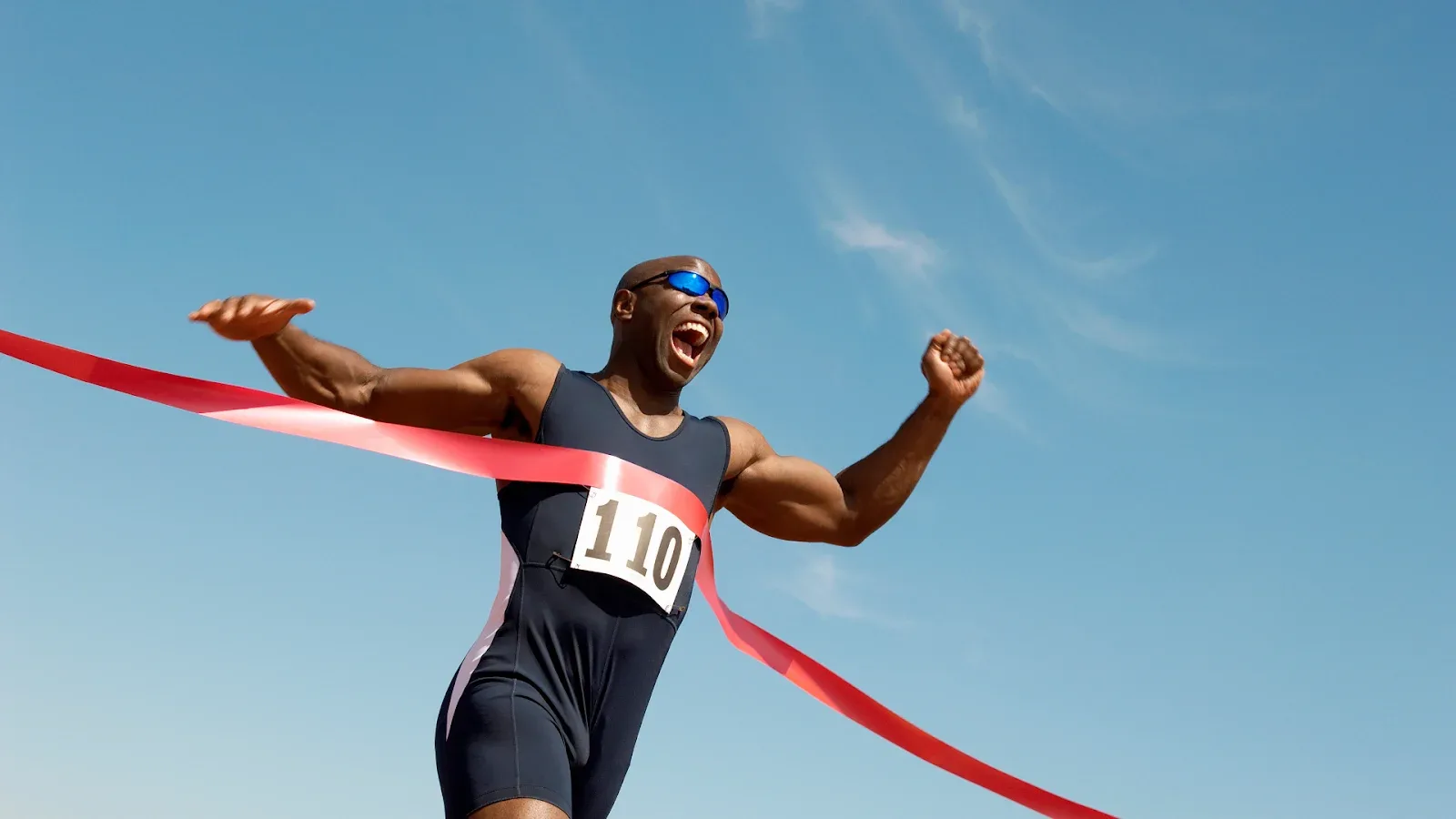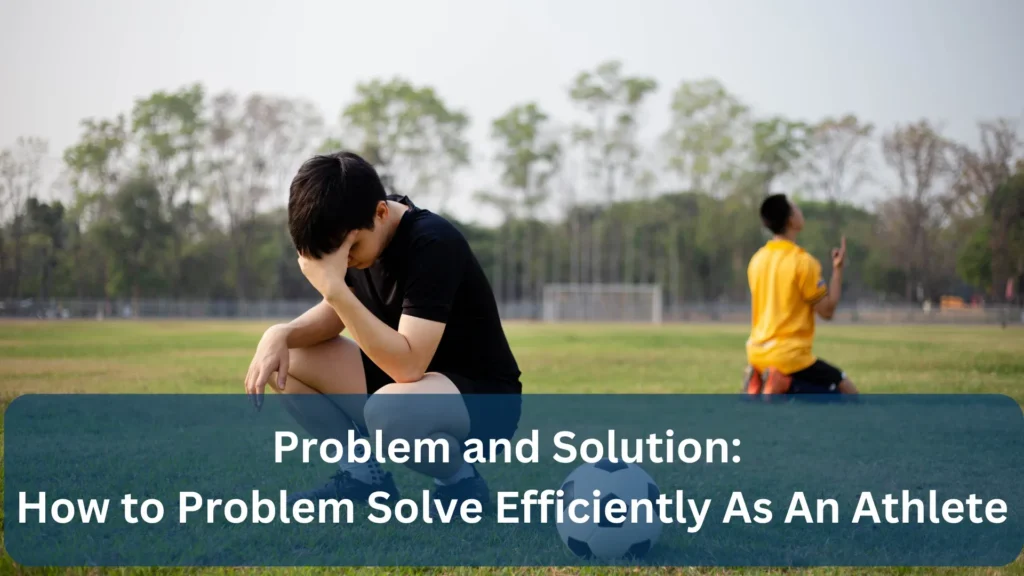
Today we’re talking about problem and solution and how to solve them efficiently, especially as an athlete.
The daily grind of an athlete is tough!
Whether you’re dealing with physical challenges or mental hurdles.
Every athlete faces problems, but the key to success lies in how you solve them.
This article explores some effective problem and solution techniques from a sports psychologist’s perspective, specifically through the lens of Acceptance and Commitment Therapy (ACT).
Understanding the Problem
Athletes, regardless of their level of expertise or sport, often encounter a variety of common problems.
Performance anxiety can manifest as nervousness or self-doubt, leading to suboptimal performance during critical moments.
Injury recovery poses both physical and mental challenges, requiring patience and resilience to overcome setbacks.
Motivation slumps are periods where athletes struggle to maintain their drive and enthusiasm for training and competition.
Additionally, team dynamics can significantly impact an athlete’s experience, as conflicts or lack of cohesion within a team can lead to stress and reduced performance.
Performance Anxiety
Performance anxiety is a prevalent issue among athletes, characterized by intense nervousness and fear of failure before or during competitions.
This anxiety can stem from high expectations, fear of letting others down, or previous negative experiences.
It often results in physical symptoms like increased heart rate, sweating, and muscle tension, which can detract from an athlete’s ability to perform at their best.
Injury Recovery
Injury recovery is another significant challenge.
Physical injuries can lead to prolonged periods away from training and competition, causing frustration and a sense of isolation.
The rehabilitation process can be slow and painful, requiring athletes to find new ways to stay motivated and focused.
Moreover, the psychological impact of an injury, such as fear of re-injury or loss of confidence, can be as debilitating as the physical aspect.
Motivation Slumps
Motivation slumps are periods where athletes experience a decrease in enthusiasm and drive.
These slumps can be caused by various factors, including burnout, lack of progress, or external pressures.
During these times, athletes may find it difficult to stick to their training routines, which can lead to a decline in performance and further exacerbate feelings of inadequacy.
Team Dynamics
Team dynamics play a crucial role in an athlete’s overall experience.
Positive relationships within a team can boost morale and performance, while conflicts or lack of communication can create a stressful environment.
Athletes must navigate these dynamics, balancing individual performance with the needs and goals of the team.
Why Problem and Solution Matters
Problem solving is not just about fixing immediate issues. It’s about enhancing overall performance and well-being.
Effective problem-solving skills enable athletes to address challenges proactively, maintain their mental health, and stay focused on their goals.
By developing these skills, athletes can better manage stress, improve their resilience, and ultimately achieve greater success in their sport.
Enhancing Performance
When athletes can efficiently solve problems, they can quickly address and mitigate factors that hinder their performance.
For example, by identifying the root causes of performance anxiety and employing strategies to manage it, athletes can maintain their focus and composure during competitions, leading to improved outcomes.
Maintaining Mental Health
Athletes who develop strong problem-solving skills are better equipped to handle the psychological pressures of their sport.
This includes managing the emotional impact of injuries, dealing with setbacks, and maintaining motivation.
By addressing these issues head-on, athletes can prevent them from escalating and affecting their overall mental health.
Building Resilience
Effective problem-solving helps athletes build resilience, enabling them to bounce back from adversity.
Resilient athletes are more likely to view challenges as opportunities for growth rather than insurmountable obstacles.
This mindset shift is crucial for long-term success and personal development in sports.
ACT Therapy Basics
Acceptance and Commitment Therapy (ACT) provides a framework for athletes to accept their feelings and commit to their values to overcome challenges.
ACT emphasizes mindfulness, encouraging athletes to stay present and non-judgmental about their thoughts and emotions.
By accepting their feelings, athletes can reduce the emotional struggle associated with challenges and focus on taking purposeful action.
Mindfulness and Acceptance
Mindfulness is a core component of ACT, teaching athletes to observe their thoughts and feelings without judgment.
This practice helps athletes become more aware of their mental and emotional states, allowing them to respond to challenges with greater clarity and composure.
Acceptance involves acknowledging and embracing all experiences, even the difficult ones, rather than trying to avoid or suppress them.
Value-Driven Action
ACT encourages athletes to clarify their core values. What truly matters to them in their sport and life.
These values serve as a guiding compass for their actions, helping them stay motivated and focused on their long-term goals.
By committing to actions that align with their values, athletes can navigate challenges more effectively and maintain a sense of purpose and direction.
Psychological Flexibility
One of the primary goals of ACT is to enhance psychological flexibility!
The ability to adapt to changing circumstances and persist in behavior that aligns with one’s values.
This flexibility allows athletes to remain resilient in the face of setbacks and continue progressing toward their goals, regardless of the challenges they encounter.
By understanding the nature of the problems they face and employing ACT principles, athletes can develop a robust problem-solving approach that enhances their performance, mental health, and overall well-being.

The Problem and Solution Approach
Step 1: Identify the Problem
The first step in solving any problem is to clearly identify it.
Being specific about the issue helps in devising a targeted solution.
For example, if an athlete is experiencing pre-game jitters, it’s important to pinpoint the exact thoughts and feelings associated with this anxiety.
Are they worried about disappointing their coach, or are they afraid of making mistakes in front of an audience?
Similarly, if an athlete is stuck on a training plateau, they should identify which aspects of their performance are not improving.
Is it their speed, strength, or endurance?
By narrowing down the problem, athletes can develop a clearer strategy for addressing it.
Step 2: Embrace the Discomfort
Acknowledging that discomfort is part of the athletic journey is crucial.
ACT encourages athletes to accept their feelings without judgment.
This step involves recognizing that negative emotions and physical discomfort are natural parts of the process.
Instead of fighting these feelings or viewing them as failures, athletes learn to accept them as temporary states.
For instance, during a particularly tough training session, instead of getting frustrated with the discomfort, athletes can remind themselves that this discomfort is a sign of growth and improvement.
Step 3: Clarify Values
Understanding what drives you as an athlete is essential for effective problem and solution approach.
Clarifying your core values helps in framing the problem and solution in a meaningful context.
Values are the underlying motivations that guide behavior and decisions.
For instance, an athlete might value perseverance, excellence, or teamwork.
When faced with a challenge, reflecting on these values can provide direction and motivation.
If an athlete values perseverance, they can view a training plateau not as a setback but as an opportunity to demonstrate their commitment to continuous improvement.
Examples of Values
- Perseverance: Continuing to train hard despite setbacks.
- Excellence: Striving to perform at the highest level in every competition.
- Teamwork: Supporting and working collaboratively with teammates.
Step 4: Take Committed Action
Once the problem is identified and values are clarified, the next step is to take committed action.
This involves developing actionable steps that align with your values and address the problem.
For example, if an athlete is facing a performance slump, they can set small, achievable goals that contribute to their long-term objectives.
These actions should be specific and manageable, allowing for gradual progress.
Combining the steps of identifying the problem, embracing discomfort, clarifying values, and taking committed action with ACT principles enhances the effectiveness of this approach.
By staying mindful and accepting of their experiences, athletes can maintain focus on their values and committed actions, leading to more resilient and adaptive problem-solving strategies.
Practical Techniques and Tools
Mindfulness exercises help athletes stay present and focused during training and competition.
These practices involve paying attention to the current moment without judgment.
Mindfulness can reduce stress, enhance concentration, and improve overall performance.
Simple Mindfulness Practices
- Breathing Exercises: Focus on your breath, noticing each inhale and exhale. This can calm the mind and reduce anxiety.
- Body Scan: Gradually shift your attention through different parts of your body, from your toes to your head, noticing any tension and allowing it to release.
- Five Senses Exercise: Engage each of your five senses (sight, sound, smell, taste, touch) one at a time to ground yourself in the present moment.
Defusion Techniques
Defusion techniques help athletes distance themselves from unhelpful thoughts and emotions.
By seeing thoughts as just thoughts, athletes can prevent them from influencing their behavior and performance.
Examples of Defusion Techniques
- Labeling Thoughts: Simply label your thoughts (e.g., “I am having the thought that I can’t do this”). This can create a sense of distance and reduce their impact.
- Thoughts as Clouds: Visualize your thoughts as clouds floating by in the sky. This imagery helps in viewing thoughts as temporary and passing.
- Singing Thoughts: Silently sing your negative thoughts to a familiar tune. This makes them seem less serious and more manageable.
Goal Setting and Tracking
Setting and tracking goals is essential for maintaining progress and motivation.
Effective goal setting involves creating SMART goals that are specific, measurable, achievable, relevant, and time-bound.
SMART Goals
- Specific: Clearly define what you want to achieve (e.g., improve sprint time by 0.5 seconds).
- Measurable: Ensure the goal can be quantified (e.g., track sprint times weekly).
- Achievable: Set realistic goals based on your current abilities and resources.
- Relevant: Align the goal with your broader objectives (e.g., improving speed for better overall performance).
- Time-bound: Set a deadline for achieving the goal (e.g., within three months).
Visualization Practices
Visualization is a powerful tool for preparing for competition and enhancing performance.
By mentally rehearsing their actions, athletes can build confidence and reduce anxiety.
Effective Visualization Techniques
- Detailed Imagery: Visualize every aspect of the performance, including the environment, physical movements, and emotions. This helps create a vivid and realistic mental experience.
- Positive Outcomes: Focus on successful outcomes and positive experiences. Imagine achieving your goals and performing at your best.
- Regular Practice: Incorporate visualization into your daily routine, spending a few minutes each day visualizing different scenarios and outcomes.
Additional Techniques and Tools
Self-Talk
Positive self-talk can significantly impact an athlete’s mindset and performance.
Developing a habit of encouraging and affirming internal dialogue can help build confidence and resilience.
- Affirmations: Create and repeat positive statements that reinforce your abilities and goals (e.g., “I am strong and capable”).
- Reframing: Change negative thoughts into positive ones (e.g., instead of thinking “I can’t do this,” reframe it to “I will give my best effort”).
Relaxation Techniques
Relaxation techniques can help manage stress and promote recovery.
These practices allow athletes to calm their minds and bodies, enhancing overall well-being.
- Progressive Muscle Relaxation (PMR): Tense and then slowly release different muscle groups to reduce physical tension and promote relaxation.
- Meditation: Practice sitting in silence and focusing on your breath or a mantra to quiet the mind and reduce stress.
- Yoga: Incorporate yoga routines that focus on stretching, breathing, and relaxation to improve flexibility and mental clarity.
Nutrition and Hydration Strategies
Proper nutrition and hydration are critical for optimal performance.
Athletes should develop and maintain routines that support their training and competition needs.
- Balanced Diet: Ensure a diet rich in essential nutrients, including carbohydrates, proteins, fats, vitamins, and minerals.
- Hydration: Maintain adequate hydration by drinking water regularly throughout the day, especially before, during, and after exercise.
- Timing: Plan meals and snacks around training and competition to maximize energy levels and recovery.
Sleep Hygiene
Quality sleep is essential for recovery and performance.
Establishing good sleep habits can help athletes maintain physical and mental health.
- Consistent Schedule: Go to bed and wake up at the same time every day to regulate your sleep cycle.
- Sleep Environment: Create a comfortable and quiet sleeping environment by minimizing light, noise, and distractions.
- Pre-Sleep Routine: Develop a calming pre-sleep routine, such as reading or listening to soothing music, to signal your body that it’s time to wind down.
By incorporating these practical techniques and tools into their routines, athletes can enhance their ability to solve problems, stay focused, and achieve their goals.
These strategies not only address specific challenges but also contribute to overall mental and physical well-being.

Real-Life Problem and Solution Examples
Case Study 1: Overcoming Injury
An athlete recovering from a severe injury used ACT techniques to accept the reality of the injury and focus on values like resilience and hard work.
By setting small, achievable rehabilitation goals, they gradually regained their strength and returned to competition.
Case Study 2: Handling Performance Anxiety
An athlete dealing with performance anxiety incorporated mindfulness and value-based actions.
By practicing mindfulness exercises before games and reminding themselves of their commitment to excellence, they managed to reduce anxiety and perform better under pressure.
Case Study 3: Breaking Through a Plateau
An athlete stuck in a motivation slump identified their core value of personal growth.
By setting incremental goals and celebrating small victories, they reignited their passion for training and broke through the plateau.
Conclusion
Effective problem-solving is key to athletic success!
By identifying problems, embracing discomfort, clarifying values, and taking committed action, athletes can overcome challenges and enhance their performance.
For more support, join the Success Stories Membership.
It’s a platform for athletes like you!
Get access to top-notch training on achieving high performance.
Learn how to deal with problems and find efficient solutions. Benefit from expert guidance and a supportive community.
Remember, you have the power to solve problems and improve your performance.
The Success Stories Membership can help you tackle any problem and solution efficiently.
Everyone faces challenges!
With the right techniques, you can overcome anything and thrive.
So, get out there, stay committed, and keep pushing towards your goals!
The problem and solution approach will be your key to success!



